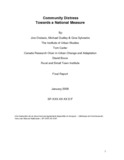| dc.description.abstract | This report developed and tested a proposed Canadian Distress Index (CDI) model capable of exploring distress across and within Canadian cities. The proposed index is discussed in terms of its ability to inform policy making concerning Canada’s urban centres. The report considers a community to be in distress when it displays significantly weaker social, economic, environmental, and physical attributes; and has insufficient internal resources and capacity to respond to those conditions. The report reviews the primary theories that explain and explore distress and are captured broadly within theories of neighbourhood change. It examined national and international precedents for measuring distress, which vary substantively in approach and application with the most comprehensive examples drawing on both qualitative and quantitative information sources. International measurements of urban distress were examined for their capacity to capture a national perspective. From this review it was determined that factor analysis would be a useful analytical tool. Twenty-four variables were drawn from the Census of Canada. Following a series of preliminary analytical steps, factor analysis was then used to develop the final models variables representing four domains comprising the Canadian distress index (CDI). Final weightings for each of the domains were proposed using statistical tests. The CDI model was then tested using 10 cities and 2500 census tracts to produce rankings of the cities and census tracts for both their composite score and also how they ranked among the four domains. It was determined that the composite ranking provides a glimpse into relevant factors, but that a local context would be necessary to fully interpret the results. This might involve the review of more local qualitative data or opinions from local experts to help understand the local contributors to distress. The Index was found effective in comparing cities within tiers in the urban hierarchy, but less capable of comparing cities across tiers. | en_US |

